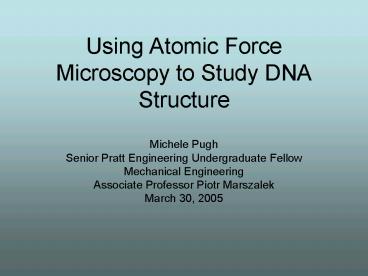Using Atomic Force Microscopy to Study DNA Structure PowerPoint PPT Presentation
1 / 13
Title: Using Atomic Force Microscopy to Study DNA Structure
1
Using Atomic Force Microscopy to Study DNA
Structure
- Michele Pugh
- Senior Pratt Engineering Undergraduate Fellow
- Mechanical Engineering
- Associate Professor Piotr Marszalek
- March 30, 2005
2
Goals
- Can techniques of atomic force microscopy can be
used to examine DNA structure? - Observe DNA structure and detect damage to DNA
molecules using two techniques using an atomic
force microscope - Imaging
- Force spectroscopy
- Become proficient in both imaging and force
spectroscopy (stretching) - Develop consistent procedures for both techniques
3
AFM imaging of DNA
- As the cantilever tip scans the sample surface,
the microscope produces a topographical image of
the sample by measuring the deflection of the tip
4
Sample preparation for imaging
- Mica surface is treated with APTES and the DNA
and proteins are diluted with TE buffer and MgCl2
solution - The DNA-protein solution heated to normal body
temperature to induce the proteins to bind to the
DNA - DNA solution deposited on the treated mica and
incubated at room temperature
5
Imaging DNA with attached proteins
- DNA in yellow at a higher elevation than the
mica surface - Proteins in white at a higher elevation than
the DNA - Sample preparation is very important in order to
minimize the appearance of aggregates and foreign
particles in the images
6
Using force spectroscopy to measure the
elasticity of DNA
- By recording data about the displacement of the
sample and the deflection of the cantilever tip,
the length and tension of the DNA molecule can be
determined - Elasticity curve of control DNA is different than
that of DNA damaged by radiation
7
Sample preparation for stretching
- A much higher concentration of DNA is needed in
order to increase the chances that the cantilever
will pick up a molecule - DNA diluted in TE buffer with NaCl solution to
stabilize the molecule - DNA solution deposited onto pure gold substrate
8
Measuring elasticity of control DNA
9
What control DNA should look like
- Obtained by Gwangrog Lee
10
Measuring elasticity of DNA exposed to gamma
radiation
11
Conclusions
- Small mechanical manipulations of DNA molecules
can be used to study the structure of the
molecule - Techniques of atomic force microscopy can be used
to detect changes in the structure of DNA
molecules associated with radiation damage
12
Possible applications of this research
- Detection of DNA damage induced by environmental
agents, such as UV or gamma radiation DNA,
specifically those that cause skin cancer - Detection of spontaneous mutations in DNA
molecules - Better visualization of the DNA and repair
protein complex
13
Acknowledgements
- Dr. Piotr Marszalek
- Dr. Qinming Zhang
- Gwangrog Lee
- Dean Martha Absher and the Pratt Fellows Program

